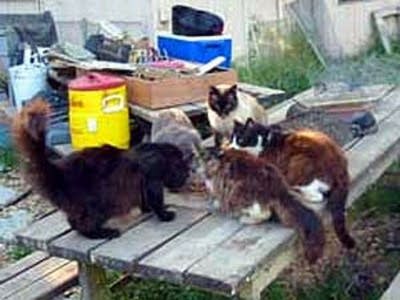Feral cat management ordinance approved by Minneapolis committee
Go Deeper.
Create an account or log in to save stories.
Like this?
Thanks for liking this story! We have added it to a list of your favorite stories.

A proposal to manage feral cats in Minneapolis drew passionate public testimony at City Hall today.
Supporters of the proposed ordinance told members of the City Council's Public Safety and Health Committee that it focuses on controlling the stray cat population rather than trying to eliminate feral cats through euthanasia.
However, some critics of the measure say more needs to be done to protect wildlife often preyed upon by feral cats and domestic cats let outdoors by their owners.
The proposal defines a feral cat as one that was born in the wild and is "unsocialized" -- or as a previously domesticated cat that has been abandoned outdoors and has lost its house training.
Turn Up Your Support
MPR News helps you turn down the noise and build shared understanding. Turn up your support for this public resource and keep trusted journalism accessible to all.
Under the proposed ordinance, groups of stray cats -- known as feral cat colonies - would be allowed in the city. But people who care for a colony of cats would have to register with a non-profit group approved by the city. Those persons would also be responsible for the care, feeding and health of the animals. They'd also have to make sure the cats are vaccinated, neutered and identified either through an implanted microchip or photograph.
"Cats are non-native... Cats also meet the state's definition of an invasive species."
Supporters of the ordinance say the best way to reduce the population of feral cats is to trap, neuter, release and feed them.
"If we could take all these animals -- all us animal groups here -- collect them up and put them indoors, we would," said Doug Edge, a feral cat colony caretaker who lives in north St. Paul. "That's clearly not going to work. There's millions of them. So this is the best we can do."
Opponents of the measure say neutering feral cats isn't enough. Stray cats should be treated as any other species that impacts the environment. Christopher Smith, president of the Minnesota Herpetological Society, said state law prohibits the release of non-native animals.
"Cats are non-native," he said. "Cats also meet the state's definition of an invasive species."
Smith said free-range cats kill not only birds, but other small mammals, reptiles and amphibians.
Matthew Anderson, executive director of the Minnesota Audubon Society, said the proposal doesn't address the environmental imbalance caused by feline predators.
"We're talking about prioritizing one single species over multiple species of birds, mammals, other animals and hundreds of thousands of individuals within those species," Anderson said.
Supporters of the measure say the only alternative to trapping, neutering and releasing stray cats is to kill them. But they say that doesn't work.
Officials with Minneapolis Animal Care and Control say the city spent $200,000 over the past five years trapping and killing feral cats. They say all it has done is create a vacuum which has been filled by other stray cats.
The committee's members approved the proposal. It will go to the full council for a vote Sept. 20. If passed, the law would take effect next January.



